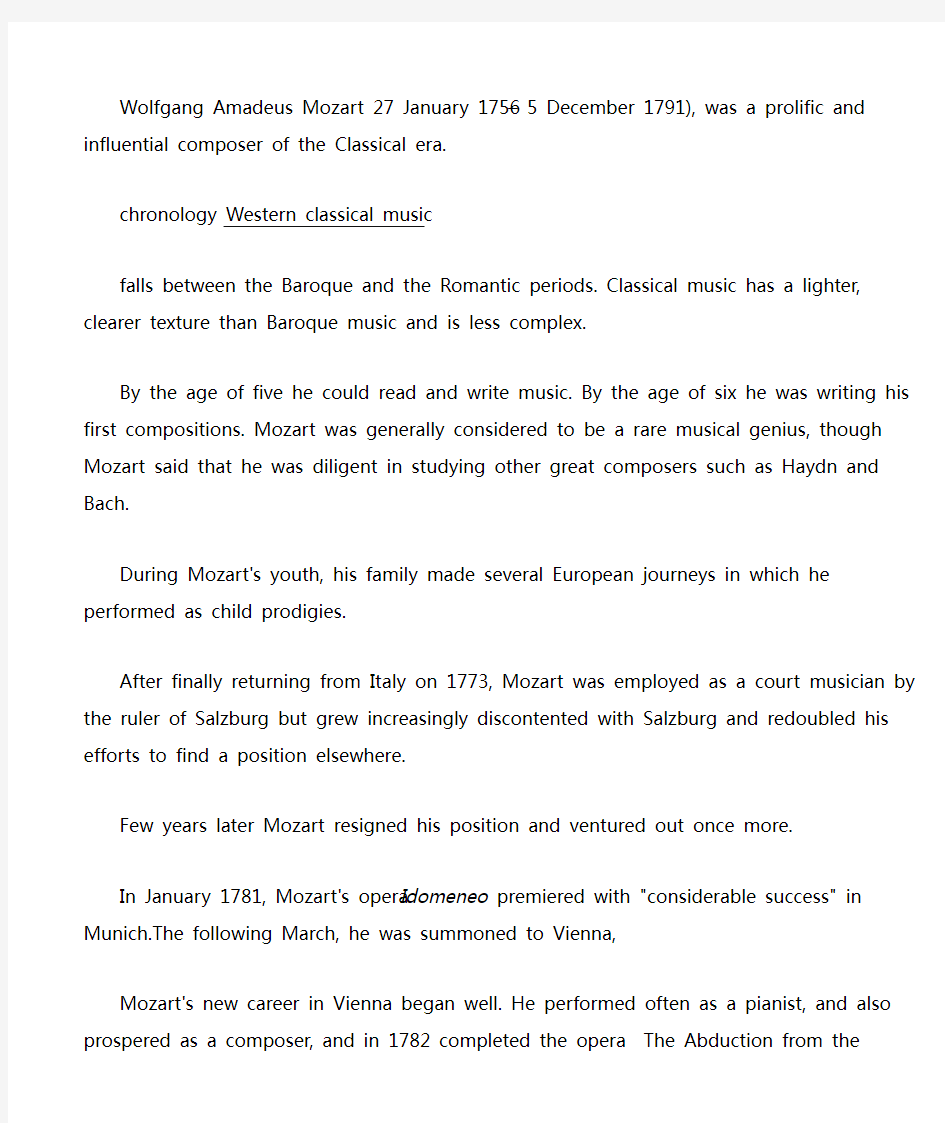音乐神童莫扎特英语介绍

- 1、下载文档前请自行甄别文档内容的完整性,平台不提供额外的编辑、内容补充、找答案等附加服务。
- 2、"仅部分预览"的文档,不可在线预览部分如存在完整性等问题,可反馈申请退款(可完整预览的文档不适用该条件!)。
- 3、如文档侵犯您的权益,请联系客服反馈,我们会尽快为您处理(人工客服工作时间:9:00-18:30)。
Wolfgang Amadeus Mozart 27 January 1756 –5 December 1791), was a prolific and influential composer of the Classical era.
chronology Western classical music
falls between the Baroque and the Romantic periods. Classical music has a lighter, clearer texture than Baroque music and is less complex.
By the age of five he could read and write music. By the age of six he was writing his first compositions. Mozart was generally considered to be a rare musical genius, though Mozart said that he was diligent in studying other great composers such as Haydn and Bach. During Mozart's youth, his family made several European journeys in which he performed as child prodigies.
After finally returning from Italy on 1773, Mozart was employed as a court musician by the ruler of Salzburg but grew increasingly discontented with Salzburg and redoubled his efforts to find a position elsewhere.
Few years later Mozart resigned his position and ventured out once more.
In January 1781, Mozart's opera Idomeneo premiered with "considerable success" in Munich.The following March, he was summoned to Vienna,
Mozart's new career in Vienna began well. He performed often as a pianist, and also prospered as a composer, and in 1782 completed the opera The Abduction from the Seraglio and it achieved a huge success. The work was soon being performed "throughout German-speaking Europe",and fully established Mozart's reputation as a composer.
The plot concerns the attempt of the hero Belmonte, assisted by his servant Pedrillo, to rescue his beloved Konstanze from the seraglio of Pasha Selim.
In December 1784, Mozart became a Freemason. Freemasonry played an important role in the remainder of Mozart's life:
Around the end of 1785, Mozart began his famous operatic collaboration with the librettist Lorenzo Da Ponte. 1786 saw the successful premiere of The Marriage of Figaro in Vienna. Its reception in Prague later in the year was even warmer, and this led to a second collaboration with Da Ponte: the opera Don Giovanni.The two are among Mozart's most important works and are mainstays of the operatic repertoire today.
It tells how the servants Figaro and Susanna succeed in getting married, foiling the efforts of their philandering employer Count Almaviva to seduce Susanna and teaching him a lesson in fidelity.
Don Giovann is an opera in two acts based on the legends of Don Juan, a fictional libertine and seducer.
Mozart's music stands as an archetype of the Classical style. At the time he began composing, European music was dominated by the style galant. Progressively, and in large part at the hands of Mozart himself, the contrapuntal complexities of the late Baroque emerged once more, moderated and disciplined by new forms.
The central traits of the Classical style are all present in Mozart's music. Clarity, balance, and transparency are the hallmarks of his work, but simplistic notions of its delicacy mask the exceptional power of his finest masterpieces, such as the Piano Concerto No. 24 in C minor, K. 491; the Symphony No. 40 in G minor, K. 550.
As Mozart matured, he progressively incorporated more features adapted from the Baroque. The influence of the Sturm und Drang ("Storm and Stress") period in music, with its brief foreshadowing of the Romantic era, is evident in the music of both composers at that time, Symphony No. 25 in G minor K. 183 is an excellent example.
Mozart would sometimes switch his focus between operas and instrumental music. He produced operas such as The Marriage of Figaro, Don Giovanni, and Die Zauberflöte.
In the opera the Queen of the Night persuades Prince Tamino to rescue her daughter Pamina from captivity under the high priest Sarastro; instead, he learns the high ideals of Sarastro's community and seeks to join it. Separately, then together, Tamino and Pamina undergo severe trials of initiation, which end in triumph, with the Queen vanquished. The earthy Papageno, who accompanies Tamino on his quest, fails the trials completely but is rewarded anyway with the hand of his ideal female companion Papagena.
